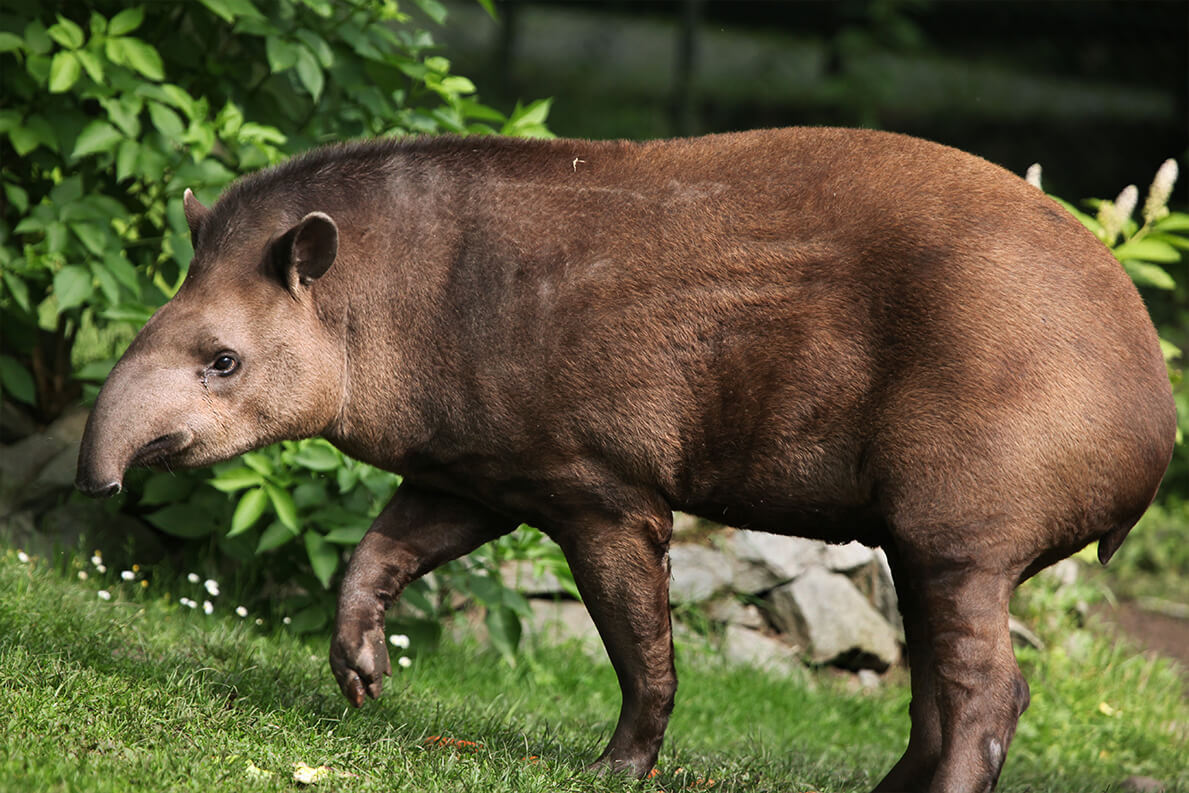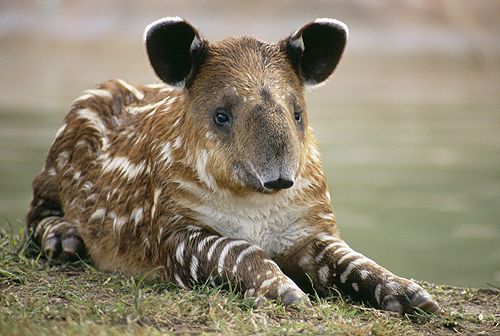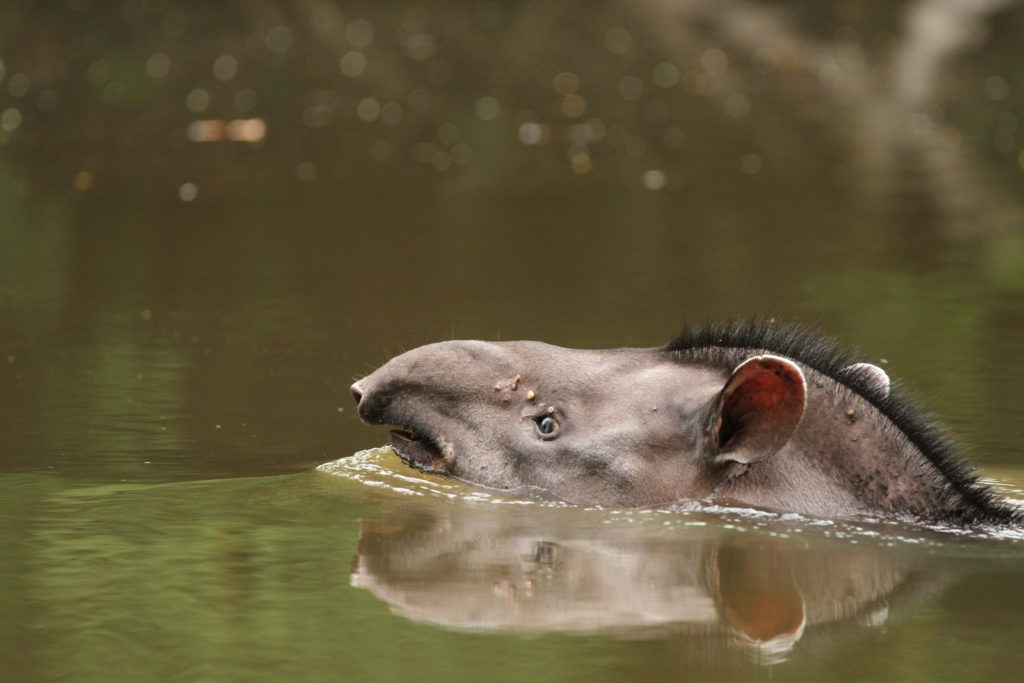“Bush Cow!” That’s the common name most Guyanese use to call a tapir. Tapirs are large, herbivorous mammals and they are similar in shape to a pig. The can be found in the rainforest of South America, Central America, and Southeast Asia. There are five extant species of tapirs, all belong to the family Tapiridae and the genus Tapirus.

Five Species Of Tapirs
New World Species
- Baird’s tapir (also called the Central American tapir), Tapirus bairdii
- South American tapir (also called the Brazilian tapir or lowland tapir), Tapirus terrestris
- Little black tapir (also called the kabomani tapir), Tapirus kabomani
- Mountain tapir (also called the woolly tapir), Tapirus pinchaque
Old World Species
- Malayan tapir (also called the Asian tapir), Tapirus indicus
The species of tapir found in Guyana is the South American tapir which is the largest surviving native terrestrial mammal in the Amazon.
Scientific Classification Of The South American Tapir
Tapir – Tapirus terrestris [Scientific name]
- Kingdom: Animalia
- Phylum: Chordata
- Class: Mammalia
- Order: Perissodactyla
- Family: Tapiridae
- Genus: Tapirus
- Species: T. terrestris
Features Of The Tapir
- Body: They are dark brown, paler in the face, and have a low, erect crest running from the crown down the back of the neck.
- Ears: Their ears are round and dark and have distinct white edges.
- Length: They can have a body length of 1.8 to 2.5 m with a 5 to 10 cm short, stubby tail. They stand somewhere between 77 to 108 cm at the shoulder.
- Weight: Tapirs have an average weight around (496 lb). Adult weight has been reported ranging from 330 to 710 lb.
- Toes: They have four toes on the front feet and three on the hind feet, which help them to walk on muddy and soft ground.
- Feet: They have webbed feet that makes them adept swimmers and they can be seen on river edges, swamps or walking along lush river bottoms in the Iwokrama Rainforest or forested areas in the Rupununi.
The Tapir’s Habitat
The tapir can be found near water in the Amazon Rainforest and River Basin in South America, east of the Andes. Its geographic range stretches from Venezuela, Colombia, and the Guianas in the north to Brazil, Argentina, and Paraguay in the south, to Bolivia, Peru, and Ecuador in the West.
The Tapir’s Diet
They are herbivores feeding on leaves, buds, shoots, small branches that they tear from trees, fruit, grasses, and aquatic plants. Tapirs will spend many of their waking hours foraging along well-worn trails, snouts to the ground in search of food.
Reproduction Of The Tapir
They mate in April, May, or June and reach sexual maturity in the third year of life. Females go through a gestation period of 13 months (390–395 days) and will typically have one offspring every two years. A newborn South American tapir weighs about 15 pounds (6.8 kilos) and will be weaned in about six months.
Young Tapirs: Baby tapirs are mini versions of their parents but have bright yellow or white spotty stripes running along their sides and legs. The striped-and-spotted coats are beneficial for camouflage.

Fun Facts About The Tapir
- Swimmers: They are excellent swimmers and divers, but can also move quickly on land, even over rugged, mountainous terrain.
- Protection: They are known to run to water when scared to take cover.
- Predator: They are preyed upon by the green anaconda, crocodilians and large cats, such as the jaguar and cougar, which often attack tapirs at night when tapirs leave the water and sleep on the riverbank.
- Lifespan: It has a life span of approximately 25 to 30 years.
- Conservation Efforts: The tapir is listed as vulnerable due to ongoing population reductions estimated to be slightly greater than 30 percent in the past three generations. The reductions are due to habitat loss, illegal hunting and competition with livestock. IUCN also estimates that the current rate of decline may continue for the next three generations (33 years). The Tapir Specialist Group, a unit of the IUCN, strives to conserve biological diversity by stimulating, developing, and executing practical programs to study, save, restore, and manage the four species of tapir and their remaining habitats in Central and South America and Southeast Asia.
Tapirs In Guyana

Indigenous Hunters Preparing The Meat for Cooking
The tapirs look like a cross between the hippopotamus, cow and elephant, due to its elongated nose. However, their closest extant relatives are the other odd-toed ungulates, which include horses, donkeys, zebras and rhinoceroses. When they want to communicate, they do so by a loud, piercing, whistling sound and they do imitations of this call which attracts hunters, making them easy hunters. Tapirs are considered living fossils, since they’ve been around for millions of years. They are also called the gardener of the forest due to their wide range and movement of great distances between different habitats. They travel from forest patch to forest patch, providing a well-designed link between them. Their travelling contributes to the dispersion of seeds, which creates a plant genetic flow between habitats. Yes, the tapir – Guyana’s largest living land mammal – is a unique animal that contributes to the growth of the forest.
Article References:
- https://en.wikipedia.org/wiki/South_American_tapir
- https://www.kaieteurnewsonline.com/2012/11/11/the-tapir-2/
- https://www.stabroeknews.com/2012/features/04/15/tapir/
- http://guyanainc.biz/daily-updates/tapirs-the-oldest-gardeners-of-the-forests/
- https://www.oas.org/children/plants/Guyana.html
- Main Image: (Tapir) https://rupununiriverdrifters.com/expeditions/corona-falls/
Discover more from Things Guyana
Subscribe to get the latest posts sent to your email.







